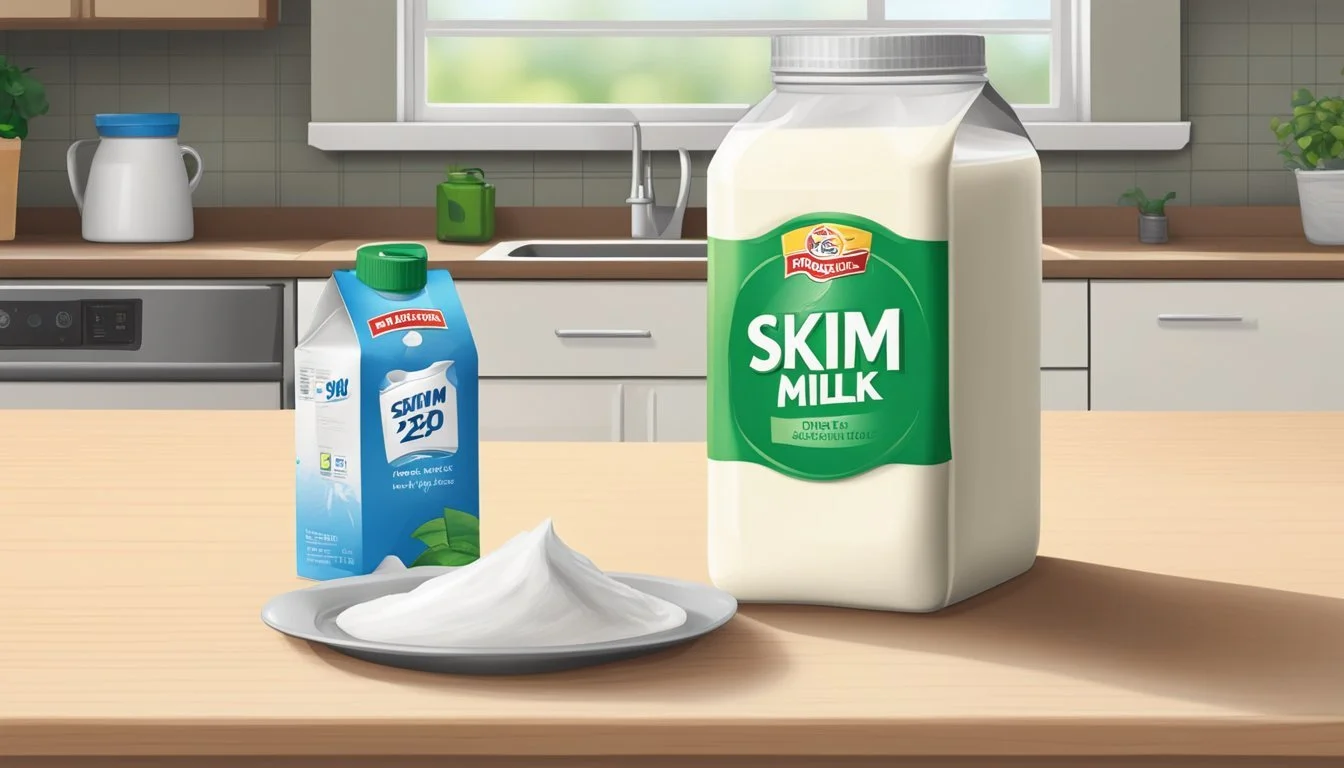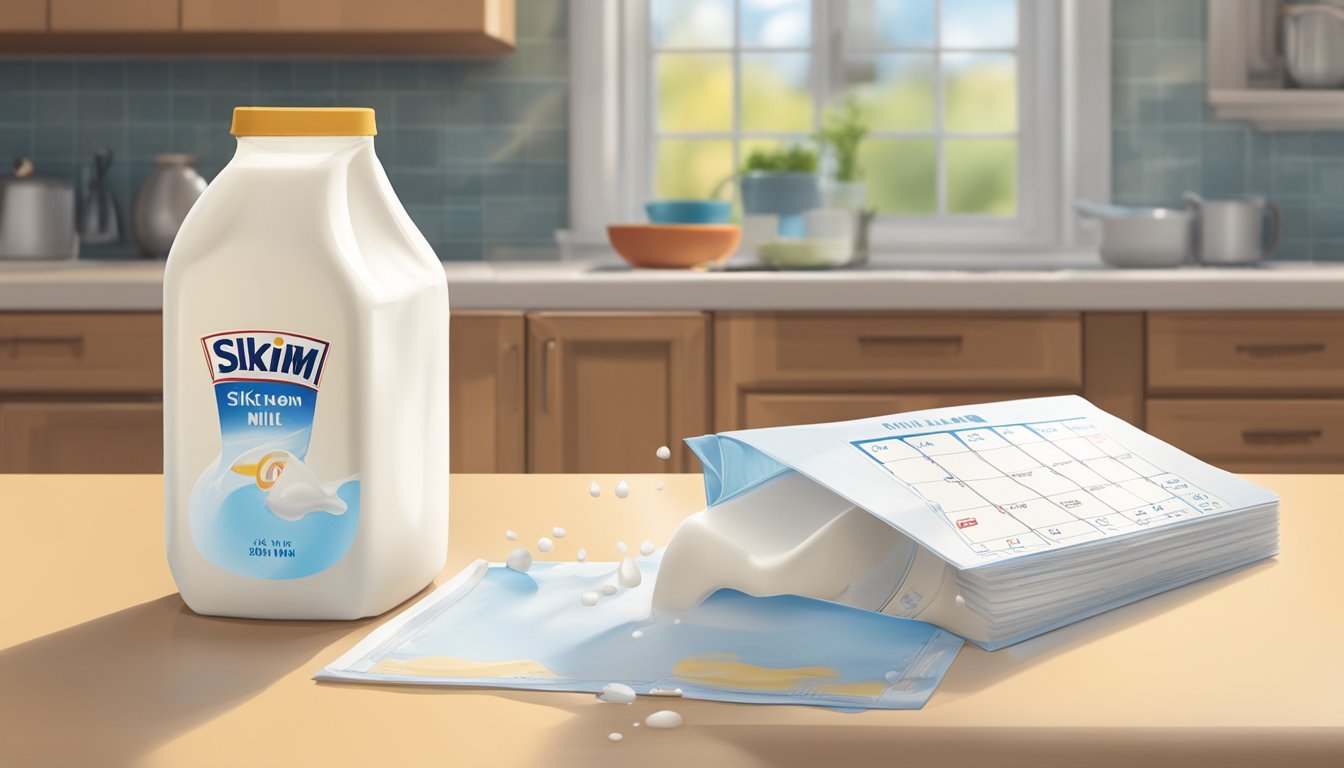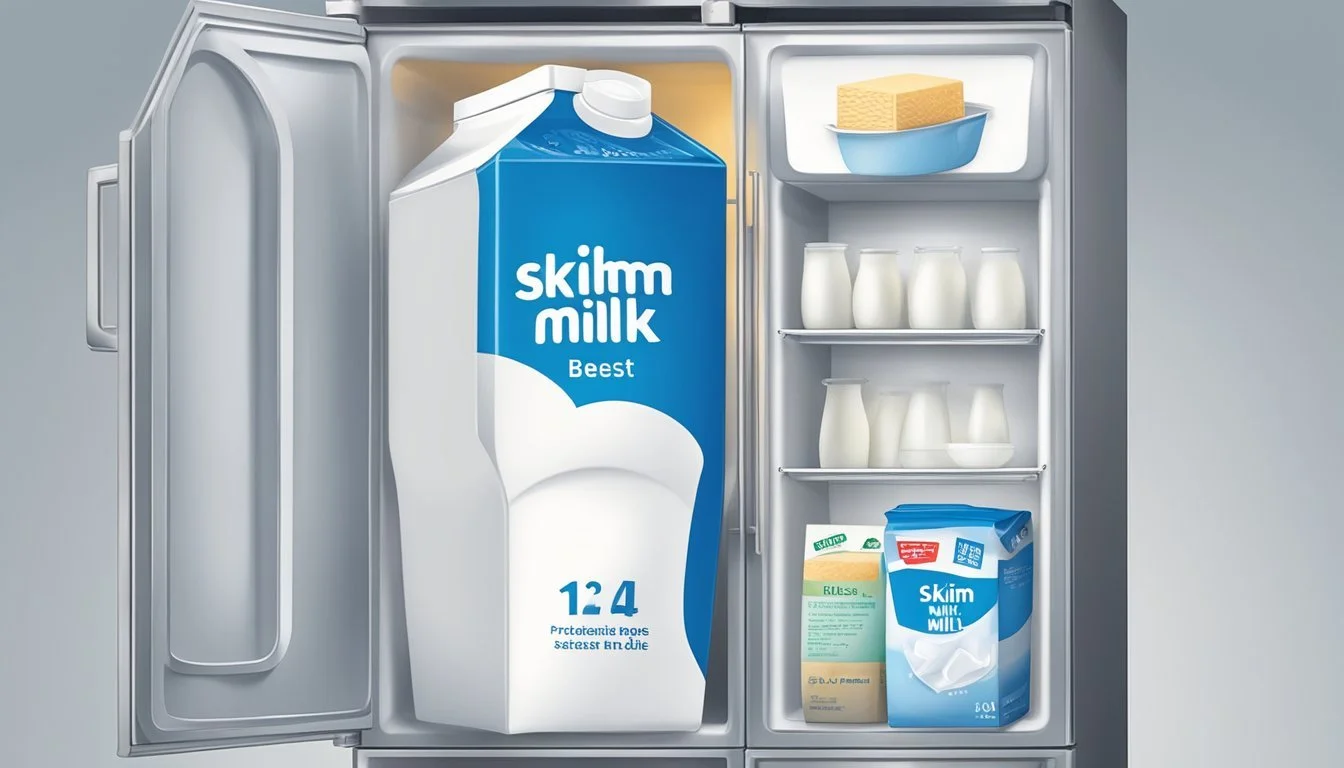How Long Does Skim Milk Last?
Shelf Life and Storage Tips
Skim milk, a popular dairy option, is notable for its lower fat content compared to whole milk. Consumers often choose it for dietary reasons, but questions arise about its shelf life in comparison to other milk varieties. Typically, skim milk will maintain its quality for up to seven days beyond the printed expiration date if kept refrigerated and unopened. The longevity of milk, including skim milk, can be influenced by factors such as storage conditions and whether the carton has been opened.
Upon opening, the shelf life of skim milk reduces and it's usually safe to consume for another 2-3 days when properly refrigerated at or below 40 degrees Fahrenheit. Consumers are advised to inspect the milk for any signs of spoilage such as an off smell, taste, or curdled consistency before use. While storage conditions can greatly influence shelf life, following guidelines and using sensory cues can ensure the milk is consumed while at its best quality.
Understanding Skim Milk
Skim milk, also known as nonfat milk, is a dairy product with the majority of its fat content removed. It stands as a popular choice for health-conscious consumers and those monitoring their intake of dietary fats.
Composition of Skim Milk
Skim milk is produced by separating the fat from whole milk, typically using centrifugation. The result is a fluid that retains its protein, carbohydrates, and soluble vitamins but has a reduced fat content. Skim milk typically contains less than 0.5% fat. This process ensures that important nutrients remain intact while providing a lower-calorie alternative to whole or reduced-fat milks.
Nutritional Profile of Skim Milk
Skim milk offers a rich source of various nutrients while being low in calories. A serving of skim milk provides:
Protein: Essential for muscle repair and growth, skim milk is a good source of high-quality protein.
Calcium: Vital for bone health, it supplies a significant amount of a person's daily calcium needs.
Vitamins & Minerals: It includes important vitamins such as vitamin D and B12, as well as minerals like potassium and magnesium.
In comparison to dairy alternatives like almond milk, skim milk typically has a higher protein content. When compared to whole milk or 1% milk, it has a significantly lower fat content, making it a suitable part of a reduced-fat diet. Skim milk's nutritional profile makes it a staple in many diets for the maintenance of general health.
Shelf Life Fundamentals
Understanding the shelf life of skim milk involves recognizing the factors that influence longevity and the signs of spoilage.
Factors Affecting Shelf Life
Temperature: Skim milk should be stored at or below 40 degrees Fahrenheit to maintain its quality. Any temperature above this threshold accelerates bacterial growth, reducing shelf life.
Sealed Containers: Unopened milk generally lasts longer. Exposure to air introduces bacteria that can hasten spoilage.
Light Exposure: Skim milk should be kept away from direct sunlight, as light can degrade its quality over time.
Expiration, Sell-by, Use-by Dates:
Expiration Date: Indicates when the milk may begin to deteriorate in quality and flavor.
Sell-by Date: Suggests when the store should remove the product from shelves; consumers can still use the product after this date if stored properly.
Use-by Date: Often the last date recommended for the use of the product for peak quality.
Identifying Spoiled Milk
Smell: Spoiled milk will have an unmistakable sour or unpleasant odor.
Color & Texture: Any discoloration or lumps may indicate spoilage. The milk should be uniformly white with a consistent, smooth texture.
Taste & Flavor: Spoiled milk often acquires a sour taste. If changes in flavor are detected, the milk should be discarded.
Consistency & Appearance: Skim milk that has an abnormal thickness or appears watery may be spoiled.
Spoilage occurs when the milk has been compromised, either through bacterial contamination, improper storage conditions, or extended storage beyond the recommended dates.
Proper Storage Techniques
Effective preservation of skim milk significantly relies on maintaining optimal storage temperatures and conditions. Adhering to strict refrigeration and freezing practices ensures that skim milk remains safe and retains its quality for an extended period.
Refrigeration Best Practices
One should store skim milk in the refrigerator immediately upon purchase to maintain its freshness. It is crucial to keep the temperature of the refrigerator below 40°F (4°C) to slow bacterial growth and preserve the milk’s quality. Skim milk should be placed on shelves rather than inside the door, as the temperature here is more stable and cooler. Using an airtight container or ensuring the original packaging is properly sealed can further shield the milk from absorbing other flavors and odors present in the fridge.
List of Refrigeration Best Practices:
Keep the refrigerator temperature below 40°F (4°C).
Place milk on interior shelves, not in the door.
Use an airtight container or maintain original packaging integrity.
Minimize exposure to air to reduce the risk of introducing bacteria.
Freezing Skim Milk
Should one opt to freeze skim milk, this can extend its shelf life even beyond refrigeration. Before freezing, it is advisable to pour out a small amount to allow for expansion as the liquid freezes. Skim milk can be stored in the freezer for up to one month without significant changes in taste and texture upon thawing. After freezing, thaw the milk in the refrigerator and never at room temperature to prevent bacterial growth. Once thawed, the milk should be consumed within a few days, and it is important not to refreeze previously frozen milk.
Table for Freezing Skim Milk:
Do Don't Allow space for expansion before freezing Freeze in glass bottles which can crack Freeze for up to one month Refreeze thawed milk Thaw in the refrigerator Thaw at room temperature
By following these specific guidelines for refrigeration and freezing, the integrity and safety of skim milk is maintained, reducing the risk of spoilage and waste.
Safety and Consumption
When considering the safety and consumption of skim milk, it's crucial to understand the health risks associated with spoiled milk and the guidelines for safe consumption to prevent foodborne illnesses.
Health Implications of Consuming Spoiled Milk
Spoiled milk poses a risk for foodborne illnesses due to the growth of bacteria such as E. coli, Listeria, and Salmonella. Individuals who consume contaminated milk may experience health issues, including diarrhea and vomiting. These symptoms are signs that the body is combating the ingestion of detrimental microorganisms commonly linked to food safety concerns. Contamination can occur at any point from production to consumption, underlining the importance of adhering to sell-by and use-by dates provided on milk packaging to reduce the risk of illness.
Guidelines for Safe Consumption
Following expiration dates on milk containers contributes significantly to the safety of milk consumption. Skim milk is typically safe to consume up to a week after the sell-by date if it has been properly refrigerated and remains unopened. Once opened, skim milk should ideally be used within 4-7 days to maintain quality and safety. To determine if milk is still consumable:
Inspect the milk for changes in color, consistency, and odor.
If any signs of spoilage are present, such as sour smell or lumps, the milk should be discarded.
Always store milk at temperatures below 40°F (4°C), and ensure the container is sealed when not in use to prevent contamination and prolong shelf life. It's critical to handle milk with clean hands and utensils to mitigate the risk of introducing pathogenic bacteria.
Consumers should also consider these measures:
Always refrigerate milk promptly.
Do not consume milk that has been left out at room temperature for over two hours.
Use milk within the recommended time frame after opening to ensure peak freshness and safety.
Practical Application and Tips
When using skim milk, it's important for individuals to consider not only its shelf life but also how it integrates into cooking recipes and other alternative uses. Freshness can affect both the taste and the outcome of food products; therefore, keeping track of the milk's condition post-expiration is crucial.
Cooking with Skim Milk
In culinary applications, skim milk can often replace whole milk to reduce fat content without significantly altering the taste or structure of the dish. For baking, however, the lower fat content may affect the moisture and binding properties. Here are a few tips for cooking and baking with skim milk:
Baking: When the recipe calls for it, one can substitute skim milk for whole milk in a 1:1 ratio. However, adding a tablespoon of oil per cup of skim milk can help mimic the fat content of whole milk, which may be necessary for some baked goods.
Sauces and Soups: Skim milk can be used to lighten up creamy sauces and soups. Although the end result may be less rich, it will still carry the desired flavor and consistency.
Alternative Uses for Skim Milk
Skim milk that is approaching or has slightly passed its expiration date can still be useful, as long as it passes the smell and appearance test and is not truly sour. Here are ways to utilize skim milk past its prime:
Sour Milk Baking: Milk that has begun to sour can actually be used intentionally in certain recipes, like scones and pancakes, which benefit from the added leavening action of the sour milk.
Non-Culinary Uses: One can use skim milk that's slightly off for non-food applications such as garden fertilizer or in beauty routines to soften skin, thanks to the lactic acid.
It is essential to store skim milk properly at 40-45℉ and to always seek fresh milk when product quality is paramount.
Understanding Food Safety Regulations
This section outlines the essential recommendations and guidelines provided by the FDA and the USDA's Food Safety and Inspection Service in relation to dairy product safety.
FDA and USDA Recommendations
The Food and Drug Administration (FDA), together with the United States Department of Agriculture (USDA), play a pivotal role in ensuring the safety of dairy products, including skim milk. They provide specific storage and handling recommendations to preserve milk quality and minimize the risk of foodborne illness.
Temperature: Milk should be stored at 40°F or lower.
Timeframe: Milk should be consumed within the "Use-By" date, if provided.
Food Safety and Inspection Service Guidelines
The Food Safety and Inspection Service (FSIS), part of the USDA, enforces strict guidelines to safeguard consumers. They oversee the inspection of dairy processing plants and ensure compliance with proper storage and pasteurization procedures.
Pasteurization: A crucial process for the destruction of harmful bacteria.
Plant Inspections: Regular checks to certify dairy plants adhere to safety standards.
The cooperation between these entities underscores the priority placed on food safety and consumer protection when it comes to perishable items like skim milk.
Miscellaneous Concerns
Understanding the environmental impact of milk waste and considering the characteristics that differentiate dairy products from alternatives are essential in managing milk consumption and shelf life.
Environmental Impact of Milk Waste
Milk waste contributes significantly to food waste, a major environmental issue. When skim milk is discarded after passing its expiration date, it is not just a loss of a consumable product but also a waste of resources used in its production, distribution, and refrigeration. The key concerns include the increased carbon footprint and the unnecessary use of water and land. Preventing milk from spoiling or using it sensibly before it becomes unsafe to consume can help mitigate environmental harm.
Carbon Footprint: Each liter of wasted milk equals a considerable carbon footprint, as dairy farming involves the emission of greenhouse gases.
Resource Utilization: Discarding milk also represents a loss of the water, feed for cattle, and energy used in the process of production, pasteurization, homogenization, and transportation.
Differentiating Dairy Products and Alternatives
Skim milk and its alternatives have varying shelf lives and spoilage indicators, such as changes in odor, texture, and taste. It is important to understand these differences for better food safety and waste reduction.
Dairy Products: Skim milk has been processed to remove the majority of its fat content and then homogenized to evenly distribute the remaining fat. This process affects its susceptibility to bacterial growth, which can lead to milk spoilage characterized by curdling, separation, unpleasant sour smell, and the development of chunks.
Bacterium involved in spoilage are psychrotrophic bacteria, which can thrive even in refrigerated conditions.
Shelf life of skim milk: Up to 7 days past expiration if kept refrigerated and stored properly.
Dairy Alternatives: Plant-based milk alternatives, such as almond, soy, or rice milk, usually have longer shelf lives due to their different nutritional compositions and lack of dairy proteins that curdle.
These are typically fortified with nutrients, including calcium and iron.
Spoilage signs may be less noticeable and might not include curdling; however, a sour or unpleasant smell and separation can still occur.







